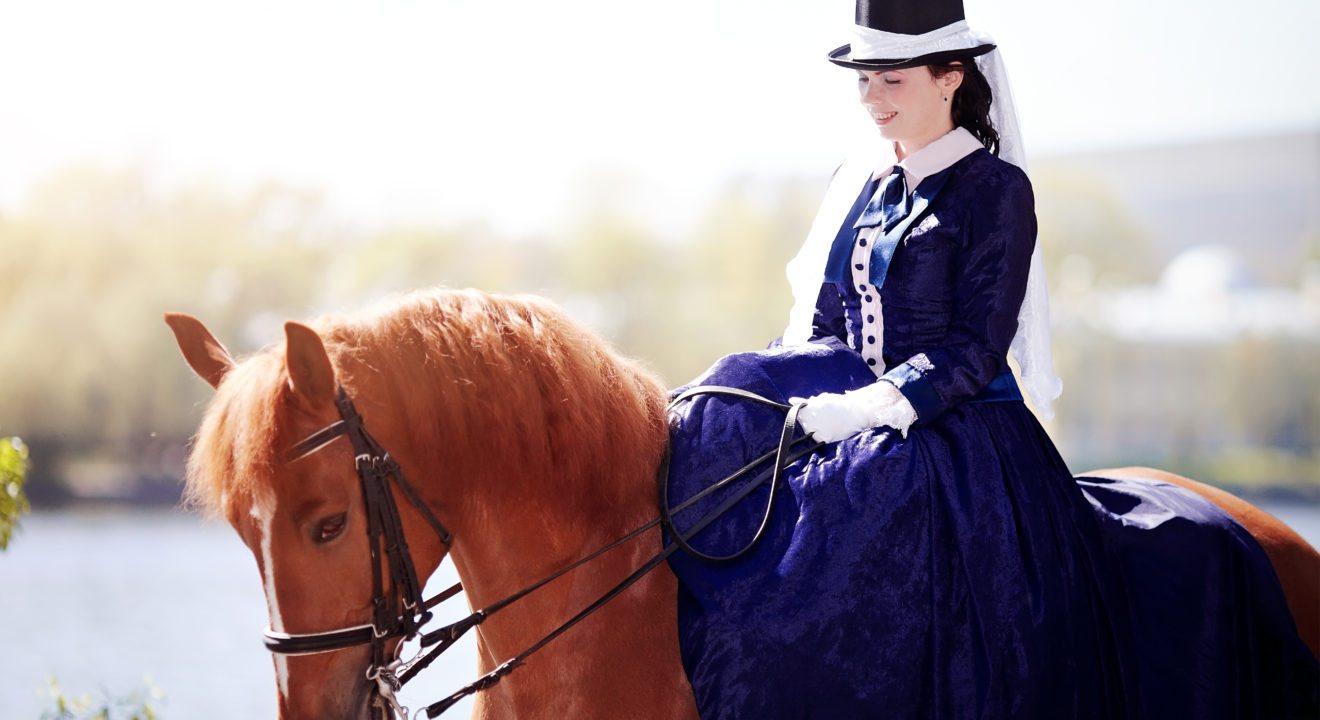Uncategorized February 14, 2017


Imagine urging your horse over a four foot fence. Now imagine the same thing, but this time you’re perched precariously across one side, clutching onto whatever you can find to stay atop your ride.
If you are a female rider, it would be very difficult to imagine what it would be like to ride side saddle. Almost all female equestrians now ride astride. But did you know that women were still fighting for the right to ride astride less than a century ago?
Before the 14th century, it was the norm for women to ride astride, just like their male counterparts. In fact, the carriage as a form of transport was not popularized until the 17th century, so for the most part, both men and women traveled by horse across narrow and unpaved roads. Female equestrians, all riding astride, were common in Europe and Asia at this time.
So at what point in history did it because the societal norm for a woman to forgo the saddle for the dangerous and debilitating side saddle?
Well, contrary to the definition of ‘bohemian,’ it was Anne of Bohemia who ironically paved the way for the side saddle’s adoption into European culture. In 1381, Anne of Bohemia set out across the country to marry King Richard II of England. On her journey, she rode on the earliest side saddle in history, which was fashioned as a sort of wooden chair with a cushioned seat.
According to the article “Sidesaddles and Suffragettes” by CuChullaine O’Reilly, “With the rise of feudalism, and its off-shoot, patriarchal politics, the need to secure a male heir was an affair of state and protecting the virginity of a potential royal bride became increasingly vital. One way to protect the royal hymen, and off-set the accidental loss of virginity, was to prohibit aristocratic girls from riding astride.” Essentially, Anne’s primitive side saddle was fashioned to guarantee the king that his new wife was a virgin at their wedding.
Soon, members of the royal court expressed their enthusiasm for the new design. Over the centuries of its popularity, the side saddle was touted as a device which preserved a lady’s modesty. To ride astride was considered vulgar and unladylike.
Despite numerous additions to the design of the side saddle, women were still far more likely to incur injuries from the unstable saddle. Women still wore long, cumbersome skirts, which often tangled in the horses’ legs. If a horse were to trip and fall, women were unable to jump clear of the saddle because they were secured by a rounded pummel, which was actually designed to keep women from falling from their precarious positions.
Despite the insecurity and possibility of injury or death, the side saddle was in vogue for hundreds of years after its introduction in 1382.
However, over the years several notable women chose to defy the immobilizing standard of side saddle riding. One such woman was Catherine the Great, Empress of Russia, who ruled from 1762 until her death in 1796. Deposing her own husband from the throne so that she could be Empress, Catherine was not the sort of woman who allowed cultural norms to keep her from power. She ignored the side saddle trend and rode astride, along with all her female attendants.
Many years later in 1913, women’s suffragist Inez Milholland fought for American women’s right to vote. During one march at the nation’s capital, “she rode at the front of the procession of 8,000 participants, astride a white horse and wearing a flowing white cape,” says the Sewall-Belmont House and Museum. Riding astride, Milholland fought concurrently for women’s right to vote and to participate with men in equestrianism equally.
By the 1930s, thanks to the public efforts of women like Milholland and countless other women’s rights activists, most women had ditched the side saddle in favor of riding astride.
In 1952, physically disabled Lis Hartel was the first women to earn a silver medal for equestrianism in the 1952 Helsinki Olympics. Although she suffered from polio, which paralyzed her below the knee, Hartel ride her horse astride to stand on the podium with her fellow medalists.
Riding sides addle is not a thing of the past, however. “Sidesaddle riding is making an unlikely comeback in the United States, greeted by many nostalgic equestrians as a delightful revival of a long-lost skill celebrating feminine modesty and elegance,” reports the Washington Post. The revival of this trend is partially attributed to the images of the ladies of UK hit “Downtown Abbey.”
Susanna Forrest, author of “If Wishes Were Horses,” says that “[riding sidesaddle] can be disparaged because it’s largely been assigned to women in the past,” but in the end, “it’s all about choice.”
Sorry, no related posts found.